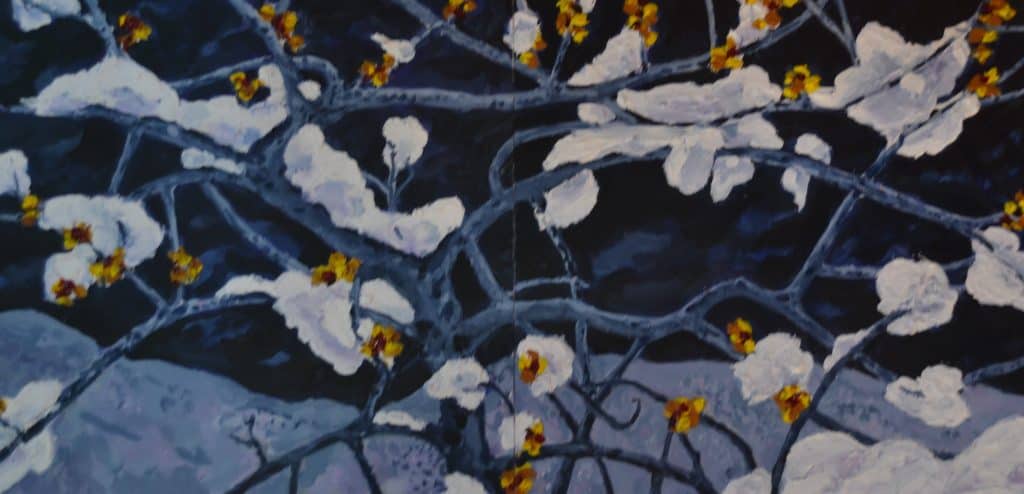Here’s what’s blooming in town this week to make your walks more enjoyable
By Laura Eisener
While most of us are just dreaming of gardens at this time of year, today is the first day of meteorological spring! Kelly Slater has been harvesting spring greens for quite a while now and can pick her salad ingredients without going outdoors, although she has also built a tiny greenhouse outside, which is producing tasty treats like perennial and annual arugulas and the colorful red veined sorrel. Indoors there are several varieties of lettuce growing in pots on a sunny windowsill, as well as kale, basil, parsley, stevia and beet greens.
Wild arugula, also known as perennial wall rocket or perennial roquette (Diplotaxis tenuifolia), is a spicier flavored leafy green that grows back for several years in the garden. Its leaves are narrower, and it tastes more strongly of mustard. If it is left to bloom, the flowers are bright yellow unlike the whitish color of the annual rocket.
Red veined sorrel (Rumex sanguineus) has long narrow leaves with red petioles and veins. The leaves have a lemony flavor. Also known as bloody dock or bloodwort because of the color, it actually looks a lot more appealing than these nicknames sound. It is a member of the buckwheat family (Polygonaceae) and unrelated to the genus wood sorrel (Oxalis spp.), a member of the wood sorrel family (Oxalidaceae), some varieties of which are sold as ornamental shamrocks at this time of year. The two plants look nothing alike, but both do contain some oxalates, which may cause problems if eaten excessively. Both are tasty and edible in moderate amounts. When young, the leaves of red veined sorrel can be added to salads, and if the leaves grow larger they can be sauteed much like spinach and beet greens.
Kelly’s greenhouse is made of flexible stems of forsythia, which grow on her land; they can be formed into half-hoop shapes, with each end buried in the ground inside a wooden edged raised garden bed. To help keep light and keep heat in, plastic sheeting is placed over the four hoops, and further heat is absorbed by water filled plastic milk jugs inside the house. This has been overall a mild winter, but the greenhouse has enabled cool weather greens to begin growing and mature much faster than they would if just planted outdoors in bare ground.
Nature provides inspiration for many of her paintings, such as the one pictured above of oak branches budding out despite snow in early spring. This painting, titled “April Snow, Breakheart” depicts some trees growing in Saugus’ own state park, Breakheart Reservation.
Mary Lou Graham’s snowdrops in her Forest Street garden are a little farther along than mine and are certainly living up to their reputation as being February bloomers. Last week I mentioned a few of this flower’s nicknames, such as fair maids of February and Candlemas bells, but I have also been reminded of some others. The French word for snowdrops is perce-neige, which means snow piercer, as often the blossoms do come up through the snow. In some parts of England, the drooping posture of the blossoms has produced the nickname of dingle-dangles. The 19th-century English poet Christina Rossetti in her poem “February” wrote of these flowers, “I’ve brought some snowdrops; only just a few, But quite enough to prove the world awake…”
Some other signs of spring are blossoms opening on the maples. The squirrels in my neighborhood seem very fond of the blossoms of silver maple (Acer saccharinum) and red maple (Acer rubrum), which are in full bloom now, even venturing out on branches that bounce with their weight to nibble on the flowers. They snap off some of the smallest branches in order to hold them while they nibble off the blossoms, then drop them on the ground when they are through. These trees produce plenty of blossoms for both squirrels and for the wind to pollinate, so there will be plenty of new trees sprouting later in the spring.
Editor’s Note: Laura Eisener is a landscape design consultant who helps homeowners with landscape design, plant selection and placement of trees and shrubs, as well as perennials. She is a member of the Saugus Garden Club and offered to write a series of articles about “what’s blooming in town” shortly after the outbreak of the COVID-19 pandemic. She was inspired after seeing so many people taking up walking.
See more photo highlights at: www.Facebook.com/advocate.news.ma



